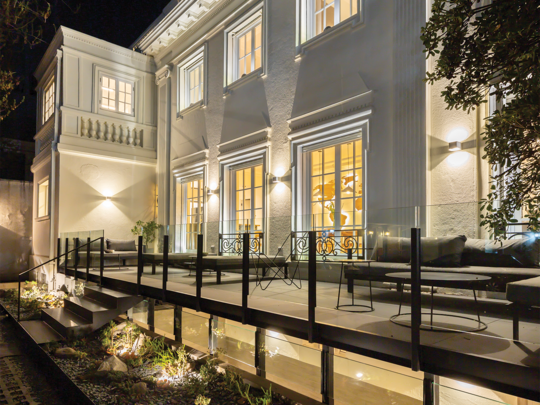From the other end of a WhatsApp call, muffled by the din of incoming reservation calls and the clatter of dishes and trays, it’s a typical night at the packed Sarkis restaurant in Villa Crespo, Buenos Aires. Established almost 40 years ago by the father of brothers Ricardo and Willy Katabian, the restaurant is fully booked even before its doors open at 8 p.m. and arriving even a half-hour later means an extended wait according to one online review.
Armenian Cuisine in Argentina
Just a few steps away from the Armenian St. Gregory the Illuminator church, in the self-contained square that houses all the major institutions of the Armenian community, the Katabian brothers cook up hundreds of delicious reasons to bring both Armenians and Argentines around the tables of their father’s namesake restaurant, who still watches over them from his photos on the wall. “The truth is my father wasn’t interested in spreading Armenian culture in Argentina when he opened Sarkis. But as time went by, we realized that on top of serving Armenian food, we were also helping preserve the cultural traditions behind it,” says Katabian.
“Sarkis began with the kitchen of my grandmother,” he continues, describing her as a typical Armenian woman of her generation who kept her family together through sheer willpower and a passion that still infuses the family-style management of the restaurant and its patrons today, notes Katabian. “At Sarkis, we learned to take care of the guest in the same way you would a guest in an Armenian home.”
With ethnic food gaining ground in Argentina on the strength of globalization and its pan-Middle Eastern cuisine adapted to the Argentine palate, Sarkis has become the unofficial culinary embassy of Armenia in a country that is home to Latin America’s largest Armen-ian community.
Still, far be it from the Katabians’ home-bred modesty to imagine that their experience would so closely resonate with fellow Argentine-Armenian Carlos Bozoghlian and his success with Carlitos Gardel, an authentic Argentine steakhouse on LA’s chic and tony Melrose Avenue. It also rings true to Arpine Zurfluh, the Yerevan-born co-founding director and chef of Los Pueblos, the Mexican eatery in Armenia’s capital that quickly became a favorite of its millennials since opening in December 2018.
As with so many Armenians, the Bozoghlians’ and the Katabians’ narratives begin on the boats and deportation routes that took their grandparents and great-grandparents from their ancestral homes into the foreign lands of Syria and Lebanon, and from there onto far more alien South America after first being refused entry into the United States. Removed by entire continents from each other, opening a restaurant was initially little more than a means to putting bread on the family table. Neither had an inkling that their family business would quickly elevate them to the high-ranks of cultural ambassadors of their respective culinary traditions.

Mexican Fare in Armenia
For Zurfluh (born Harutyunyan), her culinary adventure began at the side of her Swiss husband Daniel, who whisked her from Armenia first to Switzerland and later San Francisco, only for the two-become-four to return to her native home 20 years later.
When the time came for Zurfluh “to try something different” after more than two decades in business consulting and human resource management, it was her innate hospitality that drove her to choose the restaurant business in her search for the Zurfluh trademark. “I was always a good cook and loved to entertain,” she explains. With her unique insights into the culinary traditions of Mexico, gained after a four-month cooking stint in the Mexican kitchen of Picante restaurant in Berkeley, CA, and more than a dozen summer holidays in Mexico to back it up, her position as a chef at Los Pueblos was inevitable.
Upon her return to Armenia in 2018, the authentic recipes of her Mexican mentors at Picante served as the cornerstone of the menu at Zurfluh’s own Mexican joint. “With Los Pueblos, I didn’t try to reinvent the wheel,” she explains. “Everything I needed to get started had already been handed to me. I just needed to take it, copy it, and apply it.”
In addition to appeasing her own appetite for quality Mexican food, the opening of Los Pueblos in her hometown Yerevan took on symbolic meaning for Zurfluh. She was paying a long-standing debt of gratitude to a culture that fed and nourished in her time away from home. For all the riches offered by a life in San Francisco—the top-notch education, the corporate positions, the comforts and conveniences of America, it was “the food, the energy, the genuineness of people, the mamacitas—the family mothers of Mexico—that were the closest thing I had to home in my time there. It was all just one big reminder of home, of Armenia,” Zurfluh reflects with palpable poignancy.
But in a kitchen where there’s no one head chef and all cooks are taught to prep everything on the menu—“from sauces, meats and fried chips to our little wedding cookies”—the restaurant promised to put Zurfluh’s human resource management skills to the test.
More than just the food, I wanted to bring the culture, the energy of a real Mexican place.
With a small cadre of hand-picked cooks trained in the uncompromising art of an authentic cooking rooted in locally sourced fresh ingredients, some of which (staples like chili peppers and white onions) are outsourced from a local farmer she hired to grow in Armenia (the rest is imported from the U.S.), Zurfluh has managed to mold Los Pueblos into the must-go place for all those with a passion for Mexican cuisine and culture. “More than just the food, my business partner and I wanted to bring the culture, the energy of a real Mexican place,” she explains. The “wows” and “awesomes” from regulars like the recently-appointed honorary consul of Mexico to Armenia and local Latin American repats leave little room for doubt: Los Pueblos is a keeper on the Yerevan culinary scene.
Argentine Food in America
Similarly, the culinary muscle behind the kitchen at Carlitos Gardel is still family matriarch Azniv, who learned everything there was to know about Argentine gastronomy from none other than Doña Petrona, referred to as “the Julia Child of Argentina.” Her ambition was to weave a stronger bond with the culture of her adopted country and overcome her immigrant experience as a Greek-Armenian national, explains the general manager of the restaurant and youngest of the Bozoghlians’ three sons, Girair. But above all, “My mother’s culinary journey really began with my dad’s cravings for Argentine food,” says Bozoghlian, laughing.

Consummating the dream of previous generations of Armenians refused entry into the U.S. only 70 years earlier, the Bozoghlians ventured into the gastronomic world of LA only after a real estate venture turned sour and their capital ran dry. It was then that the family decided to wrest a failing Argentine restaurant from the hands of a passionate painter, more taken by his art than running his business, and transform it into the real deal.
No easy task at a time when Argentine cuisine was a no-show on the culinary scene of LA, and Melrose Avenue had broken down as a fashion mecca, only to surrender its position to legions of furniture showrooms spread across its Madonna-trodden sidewalks. “There was a tremendous culture change that had to happen. We really had to rebrand the Argentine experience in Los Angeles,” explains Bozoghlian.
Relying on the power of word-of-mouth back when the Internet and online review sites were little more than futuristic fantasies, the family was able to bring in its first cohort of inquisitive foodies daring enough to try some-thing new. But it’s the family’s almost-religious devotion to the authentic Argentine culinary experience, embodied in that Prime cut of Angus beef, cooked on a traditional Argentine grill under a bed of embers and served with a generous side of Jonathan Gold’s favorite Gardel’s chimichurri sauce, that landed Carlitos Gardel on the pages of the Zagat and LA Michelin guides.
“At a time when people didn’t know what to expect from an Argentine restaurant, we could have easily given it an Armenian flair by introducing traditional staples like basturma or chi keufte. But for better or worse, we didn’t, because we wanted to align ourselves with the integrity of an authentic Argentine cuisine,” explains Bozoghlian with a hint of pride in his voice.
People come to Carlitos for the good food ...the skirt steak and garlic fries...and the family comfort that goes with it.
Today, Carlitos Gardel, named after tango legend Carlos Gardel whom papa Bozoghlian once described as “a synonym for good luck,” has become an Argentine landmark in gastronomic LA, serving local enthusiasts and a not-so-insignificant contingent of Armenians—“15, maybe 20% of our guests”—the best Argentine cuisine has to offer. “People come to Carlitos for the good food (he’s talking about the skirt steak with garlic fries) and the family comfort that goes with it,” says Bozoghlian.
Picking up on that last bit with a subtle reference to William Saroyan’s famous quote about when two Armenians meet anywhere in the world, Ricardo Katabian quips, “See if they will not come together and then sit around a table for hours on end.”

Banner photo by Davit Hakobyan




















